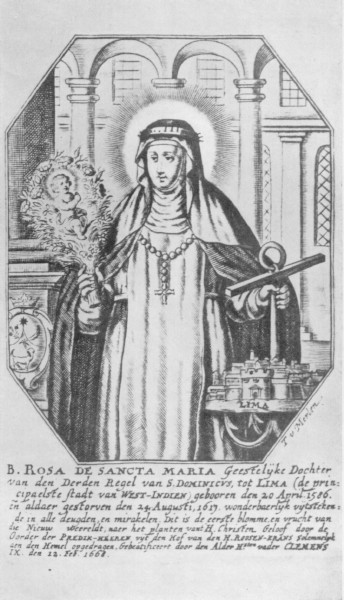| Web
and Book design,
Copyright, Kellscraft Studio 1999-2009 (Return to Web Text-ures) |
 (HOME)
|
CHAPTER IX
CONVENTS OPEN AND CLOSED LIMA is the city of bells. Exuberant wedding carols blend their metallic jingle with three solemn peals for the dying. Hoarse, ill-cast bells mingle with bells whose tones drip like honey upon the monks beneath, who, with cowls thrown back, are pruning monastery gardens, bringing water to the fig-tree from the fountain. Bells are pitched high and bells are pitched low. Bells struck from without shake off the clear ring circling their edges. There are notes with a dry sonority like the clash of bones. Sharp bells nag the persistent sinner. Soft, sweet bells lure him to prayer. Quick strokes near at hand only half conceal those distant thuds, as if the tone had been struck from the atmosphere, giving "a solemn, religious shimmer to the day." Though they are more used than those elsewhere, the bells of Lima, it is said, never grow old. The tones are of every quality, from the tinkle of little convent bells calling the sisters to midnight prayer, to the great bell of the Jesuits, whose "clash, throb, and long swoon of sound" strikes your chest. Silver and gold in this bell cling to the clear, deep notes struck from it and pulsate more than half a minute in the tone, which carries far out over city roofs to sugar-fields and vineyards. The left tower of San Pedro was built about this bell in 1666 and it cannot be removed. San Pedro has three portals on the façade, only allowed for a cathedral. The story goes that when it was building, permission was asked from Rome for a portal, which was given of course without delay. When the church with its three bronze-knobbed doors was finished, the Vatican was outraged. "What," word was sent, "you ask for one door and make three?" "For two doors one has not to have permission," came the reply, "only for three. We would have had two, anyway; it was for the extra one we needed to ask." The church was finished and consecrated. What could be done? Monastery bells waken the monks at five o'clock, masses follow every half-hour throughout the morning. Burials are tolled very early by two large, discordant bells, struck simultaneously, "a roaring, sinister, mournful peal." At noon a great caroling honors the Holy One to whom the next day is dedicated. After sunset three slow peals boom from all churches. Old people stand, men take off their hats. At eight sounds the prayer to the dead, at nine, nine peals from every bell in the city are an invitation to pray for those who die to-night. This is the time when the bell in the left tower of San Pedro rings. The left tower of the cathedral is the home of many owls, which come out at night to cry above the houses where the sick are lying to warn them of approaching death. Because innocent voices are intercessors most pleasing to God, Indian mothers in the mountains prod the poor little savage babies, flopping on their banks, with long, pointed, rat-tail silver spoons, so that they wail intermittently.  A Franciscan Friar at Home, Lima In Lima the voice of the bells is lifted to avert catastrophes and to beg for mercy in times of earthquake. When the bells cease, the importance of silence is assumed instantly, as with the dropping of the wind. A little jungle of cypress, magnolia, jasmine, pomegranate, and fig clusters about a fountain which one hears rather than sees. Contralto bird-notes seem to come from far away, like "the melodious songs of birds with yellow combs in the blessed land of Aztlan." The garden is overgrown with passion-flowers, concealing within their petals the sacred heart and nails, even the crown of thorns. Night-blooming cereus hangs darkly above the ground-glass bells of the floriponda, so ineffably sweet after sundown. Its leaves are narcotic. (In Lima one is often given a nosegay of jasmine done up in a floriponda flower.) I sat waiting on a bench in the cloister garden. Missionary priests were showing maps to little, fluted nuns. Others in black robes and furry hats paced up and down the cloister, fondling small missals and stopping around the corner to gaze at me through the wrought-iron grill. Mediaeval life in full swing, complete from a glance of the eye to the jaunty stick cocked under the Don Juan cloak! One of the priests carried two phosphorescent beetles in a piece of sugar-cane. In this convent young girls are taught that a "wife should be loving and faithful, tolerating the defects of her husband, trying to make herself esteemed by him, to soften for him the sorrows of life, cultivating abnegation, evenness of disposition, tolerance, and sweetness. She ought never to think that the faults of her husband could excuse her own." Very different was the Dominican convent of Santa Rosa. An illuminated manuscript hung at the portal, an absolution for those who worship here, sent by the Pope several hundred years ago. The recess in the wall was paved with cobblestones. Antique paintings of saints hung frameless above. Beside the huge doorway, heavily barred, was a turnstile in the wall, with solid partitions between the shelves to prevent a glimpse within. The staring word Paciencia was written above it. Utter silence! Rosa Mercédes and I tiptoed through a narrow doorway, under the word Modestia. We sat on a bench in front of a wooden grill with hexagonal openings. A vague, distinctive smell drifted through it. On the other end of the bench a woman was softly sobbing. We waited half an hour or more. The week before, the birthday of Santa Rosa had been celebrated in the cloister where she lived. The week after was now being celebrated here, where she died. As I listened, there was an explosion of fire-crackers within. Beyond a wide space on the other side of the grill was a fine wire netting, so heavy that only a shade, a brush of a veil, a suggestion of a smile could penetrate. A soft sound came through the blackness, and a voice unthinkably sweet said: "Buenos días, Rosa mía." It was the Sister Margarita, who had been thirty years behind those bars without a glimpse of friends, buried to the evils of the world, consecrated to Santa Rosa. The voice began to speak. "Our glorious Rosa! Let me tell you that when she was only three years old the lid of a heavy chest fell upon her thumb. She looked up at her mother and smiled. She concealed stinging herbs in her gloves, and when visitors came, she rubbed pepper into her eyes, so that she could neither see them nor think of what they were saying. Rosa santísima! "When she sang to her garden the canticle: 'O all ye green things of the earth, bless ye the Lord,' the trees clapped their leaves together, and even the vegetables lifted up murmurs of praise. She invented hymns to the Virgin and sang them antiphonally with a bird, though she was often surprised at being able to understand the speech of unbaptized beings. One day in the garden a black and white butterfly hovered above her. Thenceforth she understood that it was decreed that she should enter the order of Saint Dominicus. Her life from that time on was a series of acts of self-mortification. Rosa inocentísima! "She divided her day into twelve hours of prayer, ten hours of millinery work, and two hours of sleep. She was constantly aware of the presence of the angels. Rosa purísima! "At sixteen she entered the sisterhood. She prayed to a picture of Christ until it broke into a sweat. She prepared clothing for the infant Jesus by prayer — fifty litanies, nine hundred rosaries, and five days of fasting made him a little garment; and for toys, she said: 'I give my tears, my sighs, my heart, and soul.' "She wore a belt lined with nails, which she locked about her, and threw the key down a well. Half the nail belt is in the Santuario of Santa Rosa, where the well was. It went dry on the day of her death. "She died here in ecstasy on this very spot at the age of thirty. Rosa gloriosísima!" I spoke with the voice. I asked about Santa Rosa's shrine with its thousands of little silver ex-votos in Santo Domingo. "Yes, that is where she lies buried, except once a year on the thirtieth of August, when she journeys to the cathedral and back. "The daughter of a viceroy once climbed out of a palace window at night to take the veil of Santa Rosa. "When the Pope was deliberating her canonization, he was overwhelmed by a rain of roses; when it was finally celebrated, the streets of Lima were paved with silver bars. "In 1720, when they dug to build her convent, a strong odor of roses emanated from the ground. "We keep her roses blooming throughout the year; they grow from the same roots as those she cared for; the rest of the time we spend in embroidery and prayer." Such a wonderful voice! The Sister Margarita pressed a parchment-covered book close against the netting. "Here is a true life of Santa Rosa. It has never left this monastery. When you read it, you will understand why I have devoted my life to God through the mediation of our glorious Saint, our Patron, our Rosa de Lima.... She stood upon these stones in the courtyard where I now stand. Can you see why a stone has not been changed?... There is no word in this book which is not true. I know it by heart. I will give it to you...."  Santa Rosa de Lima, from Het Wonder Leven van de H. Rosa, Brussel, 1668 "Es católica?" The voice was suddenly directed toward Rosa Mercédes. "No, protestante." "Oh!…" Her voice ran down the gamut of the scale. "You will not then believe my book?" The voice addressed me. I replied that I should value the book more than any one else to whom she could have given it. "Ah," she sighed, "then that is why I wanted to give it to you." A little pause. "Good-by-ie," she said. A glint beyond the netting. "Good-by-ie, mía amíga," and Rosa Mercédes and I stood alone outside. Following is a Salutation to Santa Rosa preceding her novena, published in Lima in 1902: "God keep thee, O admirable virgin and patron of ours, Rose of Saint Mary! "God save thee, joy of the world, glory of the city, star of Lima, crown of the fatherland, most rich gold of Peru, treasure of the Indies! "God save thee, flower of the church, rosé of humility, white lily of purity, olive of peace, fire of charity, most precious pearl, most beautiful dove! "We salute thee, O most loved spouse of the Heart of Jesus! Much cherished daughter of most Holy Mary, living image of thy mistress Catherine. "We praise thee, O example of penitence! Chosen from thousands, patron of a new world. "We bless thee, O Most Fragrant Rose, Most Precious Rose, Most Innocent Rose, Most Pure Rose, Most Illustrious Rose, Most Holy Rose, Most Glorious Rose! "Rosa fragrantísima, Rosa inocentísima, Rosa purísima, Rosa ilustrísima, Rosa santísima, Rosa gloriosísima!" |